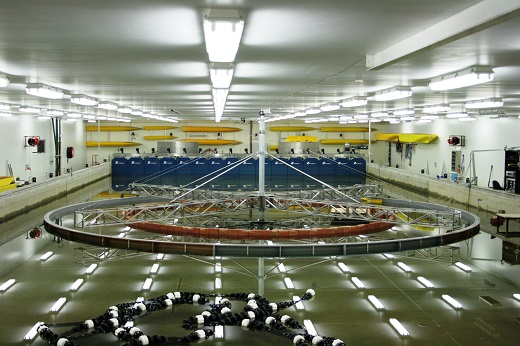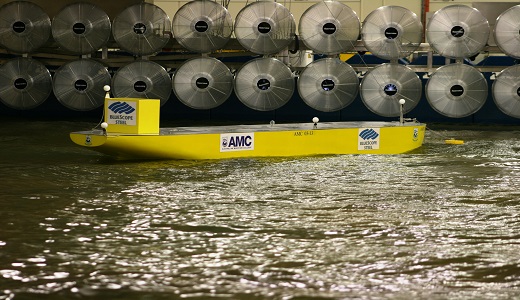
Our 35 metre long Model Test Basin simulates maritime operations in shallow water environments such as ports, harbours, rivers and coastal regions.
It is used by students, research organisations and industry to conduct a wide variety of experiments, providing hands-on experience and opportunities for experimental modelling.
The Model Test Basin has a wave-maker with 16 computer-controlled piston-type paddles that can produce a wide variety of waves at almost any finite water depth.
A wind generator with 20 individually controllable fans can be strategically positioned to obtain the desired wind direction and strength.
A state-of-the-art Qualisys digital video motion capture system consisting of a minimum of 8 and maximum of 16 cameras provides the ability to track all six degree-of-freedom motions for multiple floating models.
Semi-captive models can be towed at prescribed speeds up to 3.8 metres per second.
We have a range of multi-degree-of-freedom force balances available for use, including a large one that can be located in a pit beneath the concrete floor of the basin to measure the wave loads on structures sitting on the sea bed.
Laser diagnostic tools, such as Particle Imaging Velocimetry (PIV), can be used to quantify water flow in/around objects (we custom-make our own neutrally buoyant fluorescing particles to suit the experiment).
We have adapted stereo-videogrammetry techniques to quantify wave surfaces (using custom-made positively buoyant fluorescing particles/flakes).
The facility is very versatile and can be configured to investigate a wide range of maritime hydrodynamic problems. For example:
- Motions and loads on berthed ships, and floating and fixed maritime structures
- Restricted and confined water effects on ship resistance, trim, sinkage and squat
- Ship interaction in confined water: berthed ship-passing ship interaction; ship-bank interaction
- Performance and survivability of ocean wave energy converters
- Ship/boat-generated waves (wave wake / wash) and their effect on surrounding environment and structures
- Longitudinal wave cut experiments (standard)
At a Glance:
Length | 35 metres |
Width | 12 metres |
Water depth | 0 to 1.0 metres |
Model towing carriage speed | 0 to 3.8 metres/second |
Typical model lengths | 2 to 6 metres |

For further details please contact A/Professor Gregor MacFarlane